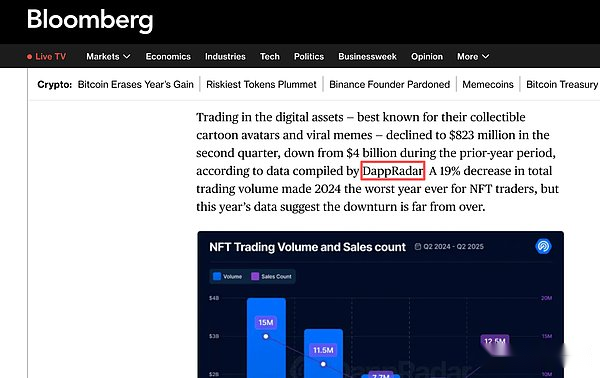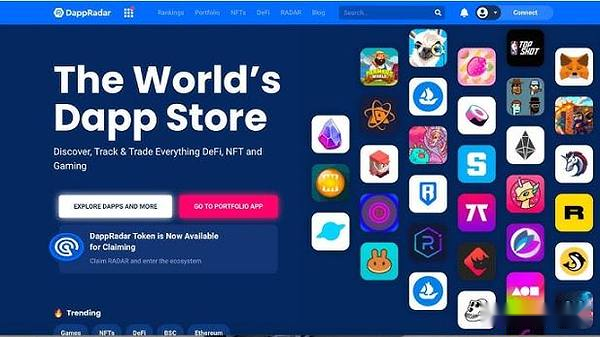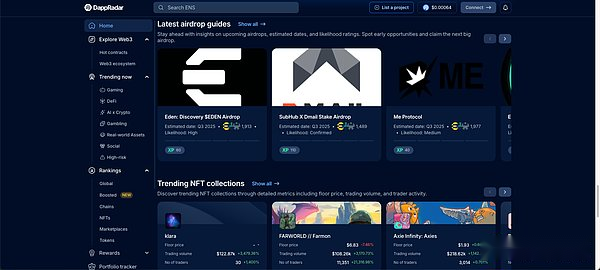
By Eric, Foresight News
On the evening of November 17, 2025, DappRadar, which has been accompanying the industry for nearly 8 years, announced that it will gradually shut down its services and will no longer continue to track blockchain and DApp data.
It is said that “a grain of sand falling on an individual becomes a mountain”, which is a perfect way to describe DappRadar.This product was born in perhaps the most noisy era of “blockchain is dead”. It accompanied Web3 from a toddler to the age of dancing, but it still failed to survive the pain of changing dynasties.The departure of products that mark the times like this reminds me of what the CEO of Nokia said at the end of the press conference when it was acquired by Microsoft 11 years ago:
“We didn’t do anything wrong, but somehow we lost.”
In those years, the data website we used together
Many newcomers to the Web3 industry may not know that DappRadar used to be a very important and authoritative data source.In addition to citations from CoinDesk and Chinese Web3 media, traditional European and American mainstream media including Bloomberg, Forbes, and the BBC have also cited DappRadar data many times.

The reason why I say authoritative is because before professional data websites (such as Nansen, Arkham, DefiLlama, etc.) and professional Web3 marketing tools (such as Cyber, Kaito, etc.) became popular, DappRadar was the portal that almost all DApps had to log in to in the early days. The complete range of projects made the completeness and credibility of its data unparalleled, and it almost became the only best way to quickly understand the basic information of new projects at that time.
DappRadar co-founder Skirmantas Januskas is from Lithuania.Unlike many industry leaders who wear multiple hats, from February 2018 to now, he has only focused on DappRadar.Before that, he had only briefly worked as a software developer at NFQ.Another co-creator, Dunica Dragos, was an operator of EA, a major American game company, in his early years. He also focused on nothing else after founding DappRadar.
DappRadar has received two rounds of investment.In September 2019, DappRadar received $2.23 million in seed funding from Naspers, Blockchain Ventures, and Angel Invest Berlin.Among them, Naspers is the South African multinational media group that spent US$32 million in 2001 to buy 46.5% of Tencent’s shares from Li Zekai, IDG and others.Subsequently in May 2021, DappRadar received $4.94 million in Series A funding from Blockchain.com Ventures, Prosus Ventures and NordicNinja VC.
The author found the record of an interview Skirmantas Januskas gave after completing financing in 2019. At that time, it was the darkest moment of Web3, but Skirmantas was full of confidence in the industry, believing that as long as the problems of user experience and finding user needs are solved, “centralized applications will become a thing of the past.”

In 2019, this passionate “stupid young man” expressed his opinions on DeFi, games and other fields, and these fields will finally usher in an explosion in 2021.Although most of the DeFi data cake was taken away by DefiLlama, its comprehensive data and deep exploration of emerging concepts such as NFT, GameFi, and Metaverse also allowed it to have millions of users at its peak.For some small projects that cannot be found on Twitter, you can see DAU jumping repeatedly between 0 and 3 on DappRadar.
Professionalism has become the biggest original sin
If we must sum up the biggest reason for the failure of DappRadar, it can only be that it is too crypto-native and ignores the importance of commercialization.
Today, when you open the homepage of DappRadar, you will find that the categories it displays include games, DeFi, NFT, gambling, and the newly added AI, RWA, and social networking that have been maintained since its inception, but you cannot see popular topics such as memes.So why is it called Skirmantas? Even tracks like NFT still insist on publishing a detailed report every quarter, and are still tracking the airdrops in the corners, but they have missed almost all the hot spots.
In the past two years, DappRadar can be said to be the only platform that covers all long-tail fields of Web3 and projects, but the problem is that it seems to only focus on the tail.

This kind of over-the-top professionalism can indeed provide Bloomberg and Forbes with high-quality material for a report, but it has no commercial value.The RADAR token launched after financing in 2021 does not seem to have any better application scenarios besides subscribing to Pro services, staking, and voting, and it also blocks the best source of subscription income.
The image established by relying on comprehensiveness in the early stage gradually turned into a shackle in the later stage.The professionalism of DeFi is not as good as DefiLlama, the token information does not seem to be as good as CMC, and the depth of research is not as deep as Bankless. The only best NFT track is in stagnant water.However, I believe that DappRadar itself has been aware of these problems earlier, so it has also accelerated commercialization, including providing high-quality data through APIs and providing advertising spaces.
After the financing in 2021, DappRadar has still been able to survive for 4 years. In addition to the financing itself, it must have brought some income through traffic monetization, but obviously these incomes are still far from the cost of providing exponentially growing massive data.In addition, since 2023, although the market continues to rise, there are not many projects with sufficient budgets. The limited budget is also spent more on KOLs, exchanges and some emerging platforms. DappRadar, which was photographed on the beach, is increasingly stretched.
As mentioned before, its coverage is too long, and the project team may not be able to determine what kind of users will refer to DappRadar information under what circumstances.In the primitive era, DappRadar provided a channel to learn about new projects, but after the great waves, the channels for learning about the few “high-quality projects” have become increasingly widespread, and the survivors of the former dynasty are no longer the only best choice.
Compared with the simple website two or three years ago, the current DappRadar is all-encompassing but appears messy. This is a reflection of excessive efforts in commercialization, which is also the embodiment of “exhausting all possibilities” in the farewell letter.For DappRadar, without continuous funding and too much financing money to spend, it is necessary to show the choice of content and restraint on advertising display on the website.However, DappRadar’s excessive insistence on professionalism or “orthodoxy” and its later practice of stacking content and advertisements after realizing that something was wrong exposed its shortcomings in operational capabilities.
In addition to its shortcomings, the Web3 data and information platform itself is a difficult business.Today, with the explosion of multi-chain data, the cost of indexing and servers has skyrocketed. The market has a high demand for high-quality data but lacks matching payment capabilities.If there are no other sources of income, relying solely on advertising and selling APIs will inevitably face competition. In order to survive, platforms with low premium capabilities will increase the concentration of advertising and reduce the user experience, and their decline seems to be a foregone conclusion.
DappRadar’s seven-year trajectory condenses the common commercialization problems of this type of project: high value, low payment, cost rigidity, and fast narrative iteration.Its closure left a clear revelation for latecomers: if the business model cannot close the loop from the first day, no matter how authoritative the data is, it will not prevent “death from blood loss.”







